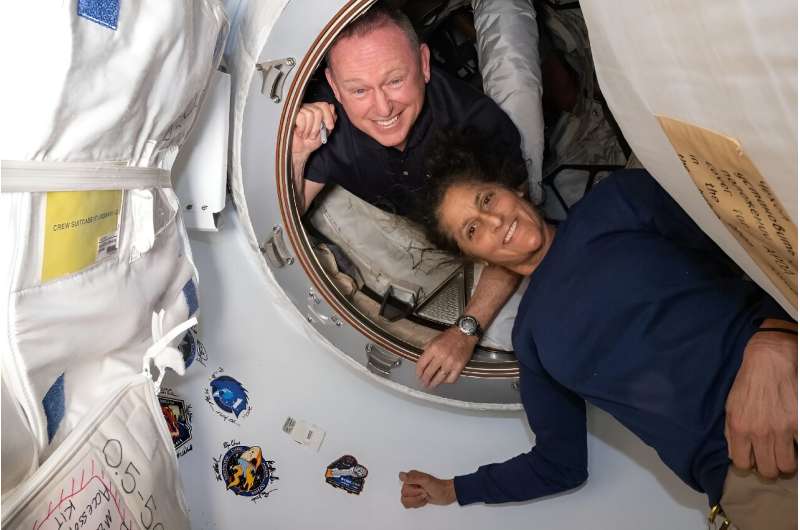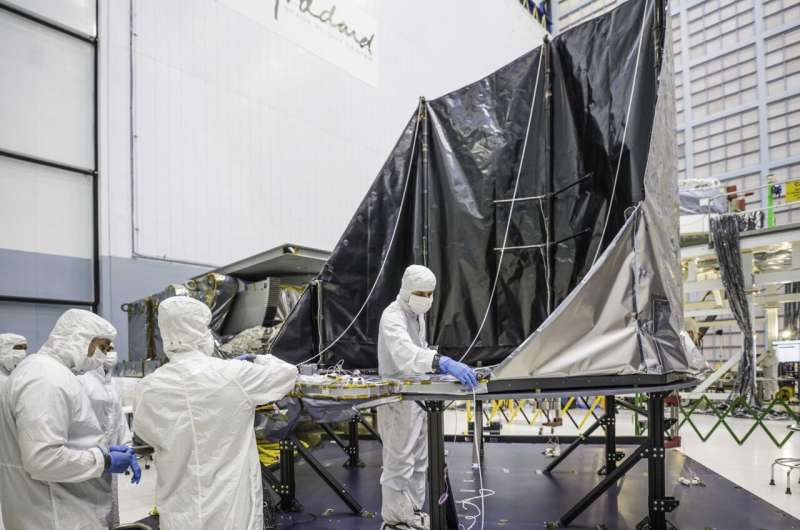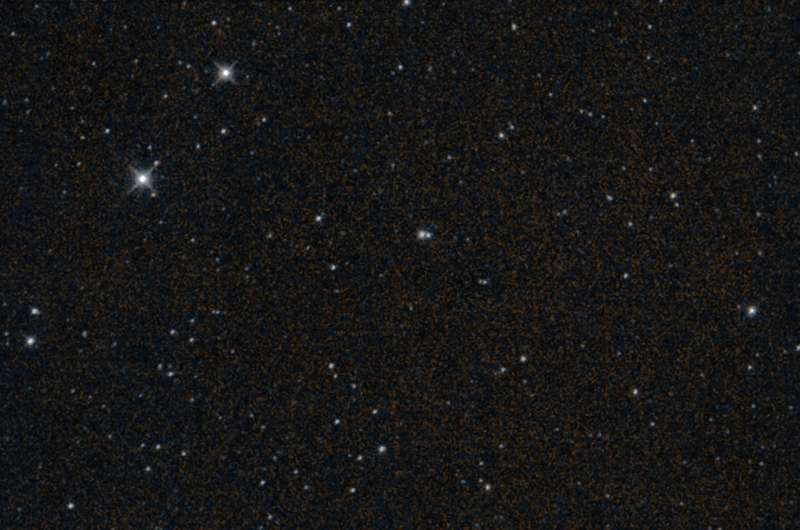
Copernical Team
NASA near-Earth defense telescope retired after more than a decade
 After more than a decade of tracking asteroids and comets that could pose a threat to Earth, NASA's Near-Earth Object Wide-field Infrared Survey Explorer is now officially shut down.
The space agency sent the final command to the NEOWISE craft Thursday from its Jet Propulsion Laboratory (JPL) in Southern California, ending its so-called planetary defense mission after more than 10 years
After more than a decade of tracking asteroids and comets that could pose a threat to Earth, NASA's Near-Earth Object Wide-field Infrared Survey Explorer is now officially shut down.
The space agency sent the final command to the NEOWISE craft Thursday from its Jet Propulsion Laboratory (JPL) in Southern California, ending its so-called planetary defense mission after more than 10 years Prepare for the Perseids and a pretty planetary pairing
 The year's long-awaited Perseid meteor shower will be accompanied by a graceful planetary conjunction. It's well worth staying up all night to watch.
The Perseid meteor shower, a celestial event eagerly awaited by millions of skywatchers around the world, is about to make its annual return to the night sky. The shower is predicted to reach its peak the morning of Monday, August 12th, but v
The year's long-awaited Perseid meteor shower will be accompanied by a graceful planetary conjunction. It's well worth staying up all night to watch.
The Perseid meteor shower, a celestial event eagerly awaited by millions of skywatchers around the world, is about to make its annual return to the night sky. The shower is predicted to reach its peak the morning of Monday, August 12th, but v New Coordination System Allows Satellite Internet and Radio Astronomy to Share the Sky
 Astronomers rely on clear skies and undisturbed frequencies to explore the universe. But as satellite technology grows, so does the potential for interference with these sensitive observations. A new collaboration between the U.S. National Science Foundation's National Radio Astronomy Observatory (NSF NRAO) and SpaceX demonstrates how radio astronomers and satellite internet providers can effect
Astronomers rely on clear skies and undisturbed frequencies to explore the universe. But as satellite technology grows, so does the potential for interference with these sensitive observations. A new collaboration between the U.S. National Science Foundation's National Radio Astronomy Observatory (NSF NRAO) and SpaceX demonstrates how radio astronomers and satellite internet providers can effect ClearSpace and Plextek Strengthen Alliance for Enhanced In-Orbit Services
 ClearSpace, a leader in space logistics and orbital servicing, has reaffirmed its partnership with Plextek, an engineering consultancy renowned for its technical expertise. Together, they are addressing critical challenges in space debris removal and satellite servicing. This collaboration combines the strengths of both companies to improve the reliability and accuracy of in-orbit operations.
ClearSpace, a leader in space logistics and orbital servicing, has reaffirmed its partnership with Plextek, an engineering consultancy renowned for its technical expertise. Together, they are addressing critical challenges in space debris removal and satellite servicing. This collaboration combines the strengths of both companies to improve the reliability and accuracy of in-orbit operations. Chinese satellite launch rocket breaks into hundred of pieces in orbit
 A Chinese Long March 6A rocket broke apart in low-Earth orbit and formed a debris field with hundreds of pieces, confirmed by U.S. Space Command.
"USSPACECOM has observed no immediate threats and continues to conduct routine conjunction assessments to support the safety and sustainability of the space domain," a U.S. Space Command spokesperson said.
NASA public affairs officer Rob Ma
A Chinese Long March 6A rocket broke apart in low-Earth orbit and formed a debris field with hundreds of pieces, confirmed by U.S. Space Command.
"USSPACECOM has observed no immediate threats and continues to conduct routine conjunction assessments to support the safety and sustainability of the space domain," a U.S. Space Command spokesperson said.
NASA public affairs officer Rob Ma Blue Origin tests out New Glenn rocket recovery crane at Port Canaveral

With the first launch of Blue Origin's massive New Glenn rocket still in the works before the end of the year, Jeff Bezos' company got to work testing out its recovery operations with the huge crane parked at Port Canaveral on August 8.
"Port Canaveral spectators got a sneak peek of our recovery operations today as we demonstrated the process of transitioning New Glenn's first stage from vertical to horizontal using our 200-foot-tall simulator," the company posted on X. "The operation validated our tooling and procedures for recovering our first stage from the landing vessel, bringing us another step closer to our first launch."
The 375-foot-tall crane arrived to the port from Germany last October and will be used when New Glenn's booster returns to the port on its "sea-based landing platform," similar to how SpaceX lands its Falcon 9 boosters on droneships.
Since it's a taller rocket, Blue Origin needed a taller crane, and it's the highest point in Port Canaveral, sitting adjacent to SpaceX recovery operations, which use mobile cranes owned and operated by the port nearby.
Meet the two Boeing mission astronauts stuck aboard the ISS

Two astronauts stranded in space may sound like the start to a big-screen science thriller, but the Boeing Starliner mission is no work of Hollywood fiction.
Astronauts Barry "Butch" Wilmore and Sunita "Suni" Williams were originally scheduled to spend a little more than a week aboard the International Space Station as part of the debut crew flight test of the Starliner.
However, the spacecraft encountered several issues during the flight, and now the two astronauts will likely have to extend their stay aboard the ISS for several months.
NASA will issue a decision by mid-August as to whether Wilmore and Williams can return on board Starliner, or if they will have to wait for their retrieval by a SpaceX craft.
NASA tests deployment of Roman Space Telescope's 'visor'

The "visor" for NASA's Nancy Grace Roman Space Telescope recently completed several environmental tests simulating the conditions it will experience during launch and in space. Called the Deployable Aperture Cover, this large sunshade is designed to keep unwanted light out of the telescope. This milestone marks the halfway point for the cover's final sprint of testing, bringing it one step closer to integration with Roman's other subsystems this fall.
Designed and built at NASA's Goddard Space Flight Center in Greenbelt, Maryland, the Deployable Aperture Cover consists of two layers of reinforced thermal blankets, distinguishing it from previous hard aperture covers, like those on NASA's Hubble.
NASA mission concludes after years of successful asteroid detections

The infrared NEOWISE space telescope relayed its final data to Earth before the project team at JPL sent a command that turned off its transmitter.
Engineers on NASA's NEOWISE (Near-Earth Object Wide-field Infrared Survey Explorer) mission commanded the spacecraft to turn its transmitter off for the last time Thursday.
NASA and USGS find a new way to measure river flows
 A team of scientists and engineers at NASA and the U.S. Geological Survey (USGS) collaborated to see if a small piloted drone, equipped with a specialized payload, could help create detailed maps of how fast water is flowing. Rivers supply fresh water to our communities and farms, provide homes for a variety of creatures, transport people and goods, and generate electricity. But river flows can
A team of scientists and engineers at NASA and the U.S. Geological Survey (USGS) collaborated to see if a small piloted drone, equipped with a specialized payload, could help create detailed maps of how fast water is flowing. Rivers supply fresh water to our communities and farms, provide homes for a variety of creatures, transport people and goods, and generate electricity. But river flows can 
